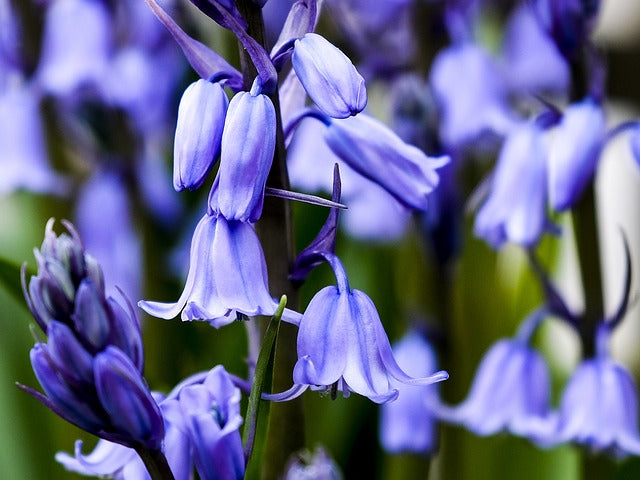
November's Flower of the Month" Bluebells
Bluebells are perhaps the most magical flower we’ve investigated so far in this series. From lore in England, Scotland, and across medieval Europe, bluebells are a glimpse into the world of fairies.
Etymology
Bluebells have a plethora of species. In North America, the prominent species is Martens Virginica, part of the borage family (also known as the forget-me-not family), while the European version is the Hyacinthoides non-scripta from the hyacinth family. Before the modern name, they were known as Endymion non-scriptus named after the greek god Endymion. In the story, Endymion is lulled into an eternal sleep by his true love and never grows old or dies, which is why the flower is linked to everlasting love.
Besides their scientific names, bluebells have been called cuckoo’s boots, lady’s nightcap, witches’ or fairies’ thimbles, and dead men’s bells. In Scotland bluebells are also called harebells, because it’s believed that witches turned into hares and hid among these flowers.
Dancing with Fairies

Bluebells are the flower of the fairies. In medieval and ancient lore, it’s said that the sight and smell of bluebells was so wonderful that it’d cause you to fall into trance and get kidnapped by fairies. Perhaps this is because they’re so often found in ancient woodlands. No matter the case, proceed with caution in a field of bluebells. But if you’d like to take the risk of playing with fairies, plant bluebells in your garden and they’ll come swarming.
It’s said that the bluebells chime at midnight to summon all the fairies. Those who believe urge you to never pick the flowers as it angers the fairies. But, bluebells grow freely in the gardens of witches, and even their presence might lead some to suspect witchcraft. Even though most folklore about bluebells warns us to leave them alone, in one instance we are advised to pick one and only one. It’s said that you can pick one bluebell and say “Bluebell, bluebell, bring me some luck before tomorrow night.” Then you’d put the flower in your shoe and be granted good luck! Or just aquire a sticky, sweet smelling sock!
In other lore, if you wear a garland of bluebells, you can’t tell a lie. And, and if you can manage to turn a bluebell inside out without tearing it, you will find your true love.
Uses
Bluebells are highly toxic, so they have no culinary uses, though many ancient people disregarded that. The main use for bluebells both now and historically, comes from their sap.
The gummy sap of the underground bulbs was used as a glue for things such as bookbinding and attaching feathers to arrows. Since the plant is so toxic, it even deterred many insects that might come chew up the books. This was most popular during the Elizabethan Era, foraying into it’s use in fashion.
Bluebell bulbs were crushed to make starchy glue that was painted onto the ruffs of collars and sleeves. Particularly when added to lace, the glue acted as a stiffening agent to add volume and interest to their garments.
Due to their toxicity, there has been little use for bluebells in modern medicine. However, their bulbs have diuretic and styptic (helps to stop bleeding) properties.
Personally, I think the best thing to do with bluebells is to appreciate them.
Fun Facts!
According to the Woodland Trust, almost half of the world’s bluebells are found in the UK, and they are quite rare (naturally) in the rest of the world.
UK, and they are quite rare (naturally) in the rest of the world.
Bees love bluebells, often nibbling a hole in the flowers to reach the pollen and nectar
They are associated with ancient woodlands and in the UK are used as indicators that the woods may be more than 400 years old
Bluebells planted by your front door are good luck because if someone unwanted comes, the little bells will ring to warn you.
Thank you for joining this month to learn about bluebells! Reading through different blog post, witch’s recipes, and historical documents was an absolute treat.
Curious to learn more? Checkout these sources!
https://curiousrambler.com/looking-for-fairies-among-the-bluebells/
https://nelliecole.com/2020/05/08/folkdays-bluebells/
https://vivscelticconnections.wordpress.com/2020/05/18/bluebells-in-irish-and-scottish-folklore/
https://annafranklinhearthwitch.wordpress.com/2021/05/03/bluebell-the-fairy-flower/